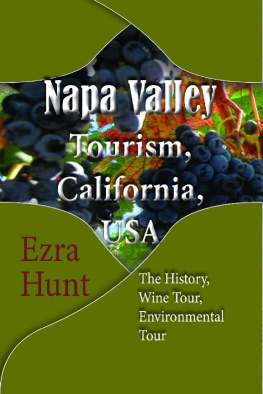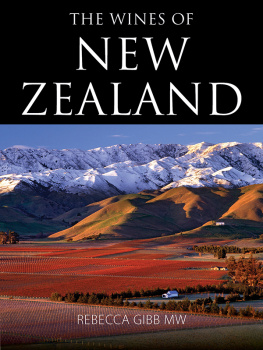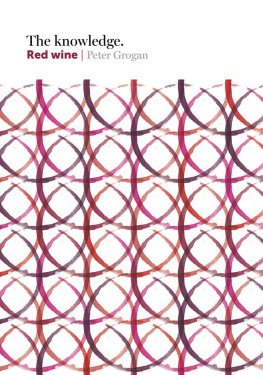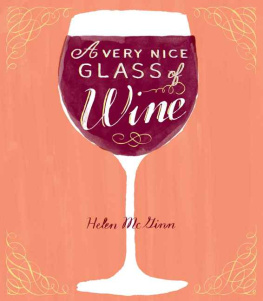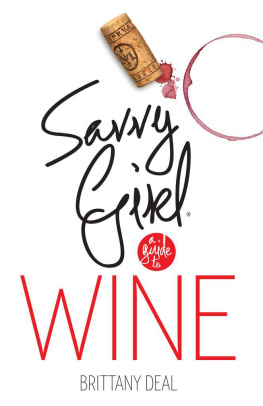
Wine Tourism Around the World
To the Wandering Islands of Wine
Wine Tourism Around
the World
Development, management and markets
Edited by
C. Michael Hall, Liz Sharples,
Brock Cambourne and Niki Macionis
with
Richard Mitchell and Gary Johnson

First published by Butterworth-Heinemann
First published 2000
Paperback edition 2002
This edition published 2011 by Routledge
2 Park Square, Milton Park, Abingdon, Oxon OX14 4RN
711 Third Avenue, New York, NY 10017, USA
Routledge is an imprint of the Taylor & Francis Group, an informa business
Copyright 2000 Taylor & Francis Ltd. All rights reserved
No part of this publication may be reproduced in any material form (including photocopying or storing in any medium by electronic means and whether or not transiently or incidentally to some other use of this publication) without the written permission of the copyright holder except in accordance with the provisions of the Copyright, Designs and Patents Act 1988 or under the terms of licence issued by the Copyright Licensing Agency Ltd, 90 Tottenham Court Road, London, England WIT 4LP. Applications for the copyright holders written permission to reproduce any part of this publication should be addressed to the publisher
British Library Cataloguing in Publication Data
Wine tourism around the world: development management and markets
1. Tourist trade 2. Wine and wine making 3. Wine industry
I. Hall, Colin Michael, 1961
338.4791
Library of Congress Cataloguing in Publication Data
Wine tourism around the world: development, management and markets/edited by C. Michael Hall [et al.]
p. cm.
Includes bibliographical references and index.
ISBN 0 7506 4530 X
1. Wine and wine making. 2. Tourism.
I. Hall, Colin, Michael, 1961
TP548 . W7725
641.32dc21 99086165
ISBN - 978 0 75065 466 1
Contents
Exhibits
Figures
Tables
Contributors
Brock Cambourne, National Capital Wine Tours, Canberra, ACT, Australia
Tim H. Dodd, Director, Texas Wine Marketing Research Institute, Texas Tech University, USA
Isabelle Frochot, The Scottish Hotel School, University of Strathclyde, Scotland
C. Michael Hall, Centre for Tourism, University of Otago, New Zealand, and School of Food and Leisure Management, Sheffield Hallam University, UK
Michael Howley, Department of Management Studies, University of Surrey, Guildford, UK
Gary Johnson, Tourism Wairapa, Masterton, New Zealand
Anna Marie Longo, 79 Eton Road, Bronxville, New York 10708, USA
Niki Macionis, Centre for Tourism and Leisure Policy Research, University of Canberra, ACT, Australia
Alison McIntosh, Centre for Tourism, University of Otago, New Zealand
Richard Mitchell, Centre for Tourism, University of Otago, New Zealand
Nigel Morpeth, Tourism, The University of Lincolnshire and Humberside, Lincoln, UK
Stephen Page, Centre for Tourism Research, Massey University Albany, Auckland, New Zealand
Robert Preston-Whyte, School of Life and Environmental Sciences, University of Natal, Durban, South Africa
Oliver Richardson, Department of Business and Management, Brunel University, UK
Liz Sharples, School of Leisure and Food Management, Sheffield Hallam University, UK
Angela M. Skinner, Department of Geography, California State University, USA
David J. Telfer, Department of Recreation and Leisure Studies, Brock University, Ontario, Canada
Jetske Van Westering, Department of Management Studies, University of Surrey, Guildford, UK
Michael Whyte, Sales Manager, Vasse Felix Winery, Margaret River, Western Australia, Australia
Preface
This book, like many good wines, has been a long time in development. First discussed between some of the editors in 1994, it has undergone a series of changes in direction until the present outline was established in 1998. Originally envisaged as a book on food, wine and tourism, it is a testament to the growth of wine tourism and the wider recognition of the interconnections between wine and tourism that this book now focuses almost exclusively on wine and tourism. It is also a book which deliberately positions itself as a serious contribution to our understanding of the wine industry. Indeed, it is remarkable that it is only recently that the business aspects of wine have started to be subject to as much scrutiny as viticulture and oenology and the history and romance of wine. Many books have been written on travelling to and within wine regions but, until now, no book has been written on the implications of that travel. However, we would note that this book is only a start in understanding the subject of wine tourism, as there are many regions, as well as many subjects, which require more attention than space allows us to provide here. If the reader will excuse the pun, this book provides only an introductory tasting of the complexities of wine tourism.
This is also a book written by people who are interested and involved in wine from both an academic and a business perspective and the editors and authors clearly hope that this book will be of interest as much to people in the wine and tourism industries as it is to students of the grape. Research on wine tourism is not always as glamorous and attractive as it might seem and, in the same way that one finds occasional corked bottles, so there are also sometimes poor wine tourism experiences. This stated, the editors would like to thank all the wineries, wine-makers and winery personnel who gave so freely of their time and expertise throughout the evolution of this book. We would also like to thank and acknowledge the input of all our contributors, whose knowledge and passion have made this book truly international in scope and focus, as well as the tremendous support provided by our publishers in Oxford.
Several individuals were especially helpful with regard to the provision of information and were always willing to answer questions, including Chris Day, Group Manager, Strategic Planning, BRL Hardy; Gladys Horiuchi, Communications Manager, Wine Institute; Mark Mathewson, Director of Hospitality for Kendall-Jackson and the Artisan & Estate family of wineries; Di Westthorpe, Project Manager, Queensland Wine Industry Project; and Jack Rasterhoff, CEO, Victorian Wineries Tourism Council. To this list we should add a number of people who have contributed to the fieldwork which has led to the development of this book. In particular we would gratefully acknowledge the assistance of Tim Bahaire, Dick and Margaret Butler, Jody Cowper, Dave Crag, Martin Elliott-White, Angela Elvey, Thor Flogenfeldt, Joanna Fountain, Sandra James, John Jenkins, Simon McArthur, Brian McIntosh, Carleen Mitchell, Nigel Morpeth, Meiko Muramaya, Stephen Page, Rachael Parr, Anna Dora Saethorsdottir, and the staff of Munslows who have all contributed to the development of this book in various ways. Finally, we would like to acknowledge the fruit of the vine that provided both inspiration and sustenance throughout the course of this project.
Wine tourism: an introduction
C, Michael Hall, Gary Johnson, Brock Cambourne, Niki Macionis, Richard Mitchell and Liz Sharples
Wine tourism is a significant component of both the wine and tourism industries. Wine and tourism have been intimately connected for many years, but it is only recently that this relationship has come to be explicitly recognized by governments, researchers and by the industries themselves. For the tourism industry, wine is an important component of the attractiveness of a destination and can be a major motivating factor for visitors. For the wine industry, wine tourism is a very important way to build up relationships with customers who can experience first hand the romance of the grape, while for many smaller wineries direct selling to visitors at the cellar door is often essential to their business success. In her standard work on wine, Jancis Robinson (1994: 980) records that
Next page




